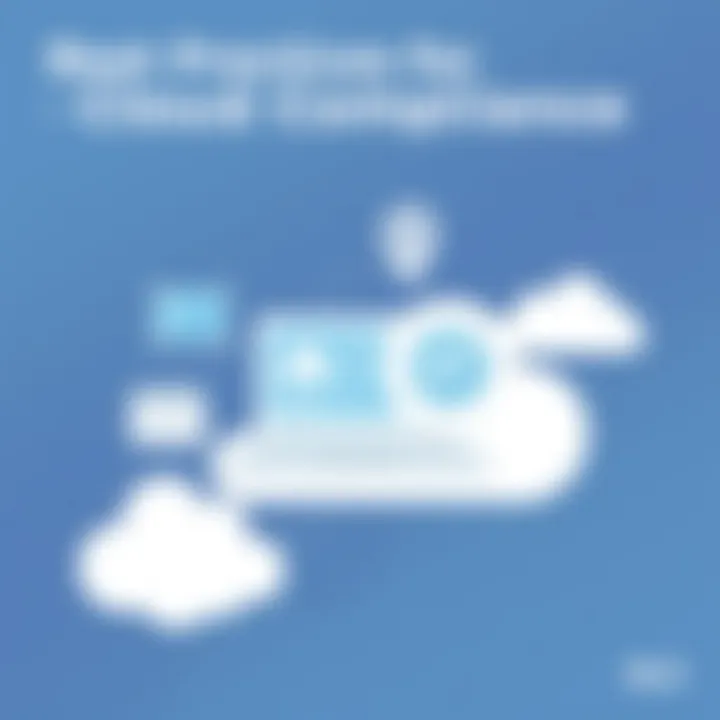Securing Your Cloud: Strategies and Considerations


Intro
In today's world of technology, the cloud has become a vital part of business operations. This shift isn't just a trend; it's a major shift in how organizations manage their data and services. However, as more companies hop on the cloud bandwagon, the need to understand how to secure these environments grows ever more crucial. It is one thing to be up in the clouds, but it’s a whole new ballgame to ensure that the data floating around there is safe from prying eyes and malicious threats.
As we dig into this topic, we will uncover the various layers of cloud security, insights into potential threats, and best practices to fortify your cloud environment. Whether you're a seasoned IT professional or a data enthusiast, your understanding of these strategies will play a critical role in protecting sensitive information and maintaining compliance.
So grab a seat, as we explore the fundamentals and complexities of securing cloud environments, ensuring you’re equipped with the right knowledge for today’s challenges.
Preface to Cloud Security
As businesses rush to adopt cloud solutions, the significance of cloud security becomes impossible to overlook. In an era where data breaches and cyber threats lurk at every corner of the internet, securing cloud infrastructures isn’t just an option; it’s a necessity. Understanding the foundational aspects of cloud security allows organizations to safeguard their digital assets while navigating the complex cloud landscape.
Cloud environments host sensitive information, ranging from personal user data to classified business strategies. Thus, the stakes are high, and the cost of ignoring security is steep. With the right strategies in place, organizations can mitigate risks and protect their data, ensuring business continuity and trust with customers.
Understanding Cloud Computing Models
In essence, cloud computing models refer to the service delivery options available in the cloud, each with its unique set of security concerns. The three primary models are Infrastructure as a Service (IaaS), Platform as a Service (PaaS), and Software as a Service (SaaS).
- IaaS offers virtualized computing resources over the internet. Here, users manage the operating systems and applications, while the provider takes care of the underlying infrastructure. It’s crucial for users to implement robust firewalls and configure security settings properly.
- PaaS provides a platform allowing developers to build and deploy applications without worrying about the infrastructure. This model, while convenient, requires rigorous security practices, particularly concerning API security, as it often involves connecting various software components.
- SaaS delivers software applications over the internet, removing the need for installation and maintenance. Security in SaaS environments heavily revolves around data protection, making sure data stored in the cloud is encrypted and protected against unauthorized access.
By grasping these models, tech professionals can tailor their security strategies to fit the specific contours of their cloud landscape.
Importance of Security in the Cloud
The necessity of cloud security can't be understated. With multiple stakeholders involved—from cloud providers to end users—the responsibility for securing data is shared. This shared responsibility model means that while cloud providers manage the infrastructure’s security, users must ensure their data remains safe from threats.
The ever-growing landscape of cyber threats magnifies the need for a dedicated focus on security. The implications of failing to secure cloud environments include potential data loss, financial losses due to downtime, and irreversible reputational damages. Security breaches can devastate organizations, and like a house of cards, they can come tumbling down if the foundational structures are weak.
"Cloud security is not just about technology; it's a mindset that all stakeholders must embrace to safeguard their assets."
Organizations must take proactive steps, such as employing rigorous authentication measures, data encryption, and regular audits, to create a robust security posture. The essence of ensuring cloud security involves a multi-pronged approach that highlights continual monitoring, vigilance against threats, and a commitment to compliance with legal regulations.
In summary, as more companies shift towards cloud-based solutions, understanding the underpinnings of cloud security not only protects data but allows organizations to thrive in a digital-first world. The ideal way forward hinges upon well-informed choices that prioritize security as much as functionality.
Key Security Threats in Cloud Environments
Cloud computing has revolutionized how businesses operate, but with this shift comes a range of security concerns. Understanding the potential threats to cloud environments is crucial for organizations aiming to safeguard their data and infrastructure. These threats can jeopardize sensitive information, resulting in financial loss and reputational damage. By shining a light on the types of threats that may arise, tech professionals can implement appropriate measures to protect their resources effectively.
Data Breaches
Data breaches are among the most pressing concerns in the world of cloud security. This threat involves unauthorized access to sensitive data, which can occur due to various reasons, such as weak access controls or misconfigured storage systems. When a breach occurs, attackers may exploit stolen credentials or take advantage of vulnerabilities in the cloud provider’s infrastructure.
Proper measures to mitigate data breaches include:
- Strong Access Controls: Implementing multi-factor authentication can be an effective strategy to thwart unauthorized access.
- Regular Security Audits: Conducting audits can expose weaknesses, helping organizations to patch vulnerabilities before they can be exploited.
"A data breach doesn't just affect technology; it impacts trust and credibility in the business realm."
Organizations should also consider utilizing security information and event management (SIEM) solutions to monitor for unusual activities in real-time.
Insider Threats
Insider threats can often be more challenging to identify and prevent than external attacks. Employees or contractors with legitimate access to cloud environments may inadvertently or maliciously compromise data integrity and confidentiality. Often, these threats stem from negligence: an employee may click on a phishing link or fail to follow security protocols, leading to a significant breach.
To counteract insider threats:
- User Education: Regular training and awareness programs help employees recognize suspicious activity and understand the importance of adhering to security policies.
- Behavior Monitoring: Tools that analyze user behavior can identify anomalies that may indicate potential insider threats, allowing for timely intervention.
Understanding the human element in cloud security is fundamental. Organizations should foster a culture of security awareness to minimize risks associated with insider threats.
Malware and Ransomware Attacks


The threat of malware and ransomware can strike fear into any organization. These attacks can cripple cloud environments, leading to data loss and operational downtime. Ransomware, in particular, has seen a surge, where attackers encrypt sensitive data and demand a ransom for its release. Both types of threats might find their way into cloud systems through phishing emails or compromised software.
To defend against these attacks, organizations can:
- Backup Critical Data: Regular backups ensure that critical data is not permanently lost, allowing for recovery if it becomes encrypted.
- Antivirus Programs: Employing robust antivirus solutions can help detect and neutralize malware before it infiltrates cloud systems.
Utilizing a layered security approach can significantly reduce vulnerabilities to malware and ransomware. Staying updated on the latest threat intelligence is equally critical for organizations to prepare defenses against evolving attacks.
In summary, understanding these key security threats enables organizations to develop a proactive stance in their cloud security strategies. By focusing on data breaches, insider threats, and malware, businesses can implement comprehensive safeguards to protect their cloud environments.
Fundamental Principles of Cloud Security
In the evolving landscape of technology, the principles of cloud security form the bedrock that organizations rely on to safeguard their data and operations in the cloud. These principles don’t merely represent a list of best practices; instead, they signify a comprehensive mindset that integrates security into the cloud infrastructure, ensuring that potential vulnerabilities are systematically addressed. The significance of these principles can’t be overstated, as they guide organizations towards a robust security posture.
Shared Responsibility Model
At the core of cloud security lies the Shared Responsibility Model, an essential concept that delineates the division of security responsibilities between the cloud service provider (CSP) and the customer. In simpler terms, while the provider is generally responsible for the infrastructure’s security, the customer must ensure that their applications and data remain protected.
This model varies across different cloud services such as Infrastructure as a Service (IaaS), Platform as a Service (PaaS), and Software as a Service (SaaS). For instance, in IaaS environments, the customer has control over the operating system, applications, and data, which means they must implement their own security measures. Conversely, in a SaaS model, the CSP handles much of the security, but customers still need to manage user access and data integrity.
Understanding this shared dynamic helps organizations prioritize security actions appropriately. Here are some key points to consider regarding this model:
- Define clear roles: Organizations must clearly delineate who is responsible for each aspect of security to avoid any gray areas that might expose vulnerabilities.
- Regular assessments: Regular assessments and audits should be conducted to ensure responsibilities are understood and maintained.
- Educate employees: Training staff about their roles in cloud security can mitigate risks associated with human error.
"Shared responsibility means clarity on who owns what in the security landscape, paving the way for a more secure cloud environment."
Defense in Depth
The principle of Defense in Depth embodies a layered approach to securing cloud infrastructure. By employing multiple security measures across various layers, organizations can bolster their defenses against potential breaches. Instead of relying on a single security control, this strategy ensures that if one layer fails, others remain to offer protection.
Here are some critical elements of this principle:
- Layered Security Controls:
- Access Management:
- Regular Monitoring and Updating:
- Firewalls at the network perimeter
- Intrusion detection and prevention systems
- Endpoint protection for all devices accessing the cloud
- Strong user authentication protocols, such as multi-factor authentication, can serve as a secondary layer if passwords are compromised.
- Role-based access ensures users have the minimum required access which minimizes risks.
- Continuous monitoring of all systems and regular updates of security protocols keep defenses strong against emerging threats.
- Implementing security information and event management (SIEM) can help in real-time threat detection.
By adopting a Defense in Depth strategy, organizations can create a more resilient security framework—one that not only mitigates risks but also fosters a proactive culture of security awareness. Success in cloud security relies on understanding these fundamental principles, as they collectively reinforce an organization's ability to protect sensitive information and maintain trust with clients and stakeholders.
Implementing Security Best Practices
Implementing effective security measures is not just a recommendation; it’s essential when it comes to protecting cloud environments. These practices help safeguard sensitive data and ensure compliance with industry standards. Adopting best practices can mitigate risks, bolster resilience against potential threats, and build trust with stakeholders. Organizations gain a multilayered defense, making it significantly harder for threats to penetrate. There’s an old saying that goes, "prevention is better than cure," and in the cloud security realm, this rings especially true.
Identity and Access Management
Identity and access management (IAM) is vital for controlling who has access to your cloud resources. Better IAM means better security. Protecting data starts with ensuring the right people have the right access at the right time. In today’s digital landscape, where cyberattacks are rampant, IAM is more than just a good practice—it's a necessity. A key characteristic of IAM is its ability to streamline user experiences while maintaining a robust security posture.
User Authentication Methods
User authentication is the first line of defense in IAM, acting almost like a bouncer at a club, letting only the right people in. The most popular user authentication methods include multi-factor authentication (MFA) and biometrics. The unique thing about MFA is it requires additional verification steps beyond just a password, making unauthorized access much harder. For instance, even if a password gets compromised, the hacker still needs that second factor, which may be a text message or an app notification.
However, while MFA greatly enhances security, it isn’t without its downsides. Users may find it cumbersome, especially if they’re in a hurry. Balancing security and user convenience is crucial.
Role-Based Access Control
Role-based access control (RBAC) allows organizations to assign permissions based on user roles, ensuring that employees only access information necessary for their job functions. This minimizes unnecessary exposure to sensitive data, which is a significant advantage in safeguarding information. Think of RBAC like a restaurant—waiters only access the kitchen, while customers only see the dining area.
Yet, a downside to RBAC is the complexity in setup and management. As organizations evolve, roles can shift, making it crucial to regularly review and update access controls to reflect current requirements.
Data Encryption


Data encryption is paramount in protecting sensitive information. Whether data is at rest on a server or in transit over networks, implementing robust encryption protocols keeps confidential data shielded from prying eyes. Encrypted data remains unreadable unless the receiver possesses the correct decryption key, thereby adding another layer of security.
At-Rest Encryption
At-rest encryption secures data stored on disk, databases, or cloud services, meaning that even if someone gets unauthorized access to storage, they can’t read the data without the encryption key. This is crucial for compliance with data protection regulations like GDPR.
Nonetheless, the challenge of managing encryption keys emerges as organizations scale. Losing keys or mismanaging them can lead to data breach scenarios or irretrievable data.
In-Transit Encryption
In-transit encryption focuses on securing data as it travels between services, devices, or networks. A common practice here is the use of TLS (Transport Layer Security), which encrypts data packets as they transit. This method is crucial in preventing eavesdropping or tampering during data transmission.
The main advantage lies in the increased protection against interception, especially during online transactions. Nevertheless, it requires maintaining updated certificates and ensuring that both ends of the communication support the encryption method.
Regular Security Audits
Conducting regular security audits is like giving your cloud infrastructure a health check. These audits are essential for identifying vulnerabilities and ensuring compliance with regulations. They provide an opportunity to assess the effectiveness of current security measures and identify potential areas for improvement.
While audits can sometimes be time-consuming and resource-intensive, they are invaluable for proactive security management. By staying ahead of potential threats, organizations can adapt their security practices before an issue arises.
Compliance and Regulatory Considerations
Navigating the complex web of cloud security isn’t just about technology; compliance and regulatory considerations play a crucial role. Organizations must not only protect their data but also ensure they are adhering to legal standards. Failure to meet these standards can result in hefty fines, legal action, and damage to reputation. Plus, regulatory compliance is often a moving target, necessitating constant vigilance and adaptability.
Many regulations are tailored to specific industries or regions, bringing unique requirements that must be addressed in cloud environments. Understanding these parameters helps safeguard both organizational assets and customer trust. Achieving compliance can also enhance operational efficiency, fostering a culture of responsibility within the organization, ultimately leading to better security measures.
Understanding Compliance Requirements
GDPR
The General Data Protection Regulation, better known as GDPR, is that core piece of legislation in the European Union that outlines how personal data should be handled. This regulation has a broad applicability, being relevant to any organization that processes the data of EU citizens, regardless of the company's location. One key characteristic of GDPR is the power it gives to individuals, allowing them greater access, control, and rights over their personal information.
Under GDPR, organizations face strict guidelines about data processing and storage. Adhering to GDPR is not just about following rules; it's about fostering trust with users — and who wouldn’t want a little more of that? However, the unique feature of GDPR lies in its hefty fines; violators can be penalized up to 4% of their annual global turnover or €20 million (whichever is greater).
- Advantages: Enhances customer trust and minimizes data breach risks.
- Disadvantages: Compliance can be costly and demand significant changes to existing systems.
HIPAA
The Health Insurance Portability and Accountability Act (HIPAA) is particularly significant for organizations handling health data in the United States. This regulation establishes standards for protecting sensitive patient information. One principal aspect of HIPAA is its specific focus on data confidentiality and security, creating strict protocols around how health information is accessed, shared, and stored.
What makes HIPAA stand out? It mandates implementing safety measures and ensure employees are trained on safeguarding data. For organizations serving the healthcare sector, compliance is not merely a checkbox; it's central to their credibility.
- Advantages: Helps mitigate risks associated with data breaches in sensitive sectors.
- Disadvantages: Requires ongoing training and system audits, potentially straining smaller entities.
PCI DSS
The Payment Card Industry Data Security Standard (PCI DSS) delves into protecting card payment information. Organizations that accept credit cards must comply with this set of guidelines. A key characteristic of PCI DSS is its comprehensive approach to securing card transactions, covering everything from encryption methods to network segmentation.
Unique to PCI DSS is its tiered compliance levels based on transaction volume, meaning a retailer processing millions of transactions per day adheres to stricter standards than a corner store doing a handful. Achieving compliance can bolster customer confidence and secure financial transactions.
- Advantages: Builds trust with consumers and reduces fraud risk.
- Disadvantages: Compliance can be resource-intensive, requiring regular assessments and updates to security protocols.
Implementing Governance Frameworks
To navigate the sea of compliance requirements, organizations must implement robust governance frameworks. This ensures that policies, practices, and procedures align effectively with the regulations applicable to their operations. Frameworks like ISO 27001 or NIST can serve as valuable guides, helping organizations establish a well-structured approach to information security and regulatory compliance.
By integrating these frameworks, businesses can create a culture of compliance, where every employee understands their role in maintaining security standards. This holistic approach not only simplifies adherence to regulations but also strengthens overall operational integrity.
The Role of Automation in Cloud Security
In today’s increasingly complex cloud environments, automation plays a pivotal role in fortifying security measures. Organizations are racing to maintain optimal security while managing a growing array of services and controls. The use of automation allows for faster, more accurate responses to potential threats, which is crucial given the dynamic nature of cloud vulnerabilities. By implementing automated processes, companies can ensure that their cloud security posture is not only proactive but also adaptable to an array of new threats.
Automated Threat Detection


Automated threat detection acts as the first line of defense in a robust cloud security strategy. Leveraging advanced algorithms, organizations can monitor network traffic, user behavior, and application activities in real-time. This approach minimizes human error, which can often lead to overlooked vulnerabilities.
Key benefits include:
- Speed: Automated systems can analyze vast amounts of data in seconds, flagging unusual behavior almost instantly.
- Consistency: Unlike human oversight, automation maintains uniformity in threat detection processes, reducing the likelihood of missed alerts.
- Scalability: As organizations grow, so do their security needs. Automation accommodates expansion without requiring equal increases in personnel or resources.
"In the realm of cloud security, standing still is akin to moving backward. Automated threat detection ensures we keep ahead of emerging vulnerabilities."
However, it’s important to remain aware of potential pitfalls. Over-reliance on automation can create a false sense of security. Tools need to be well-calibrated and continuously updated to align with evolving threat landscapes.
Infrastructure as Code (IaC)
Infrastructure as Code, or IaC, revolutionizes cloud security by allowing infrastructure to be managed using code, enabling easier provisioning, configuration, and maintenance of cloud resources. This method not only increases operational efficiency but also adds layers of security through various automated checks.
When properly implemented, IaC facilitates the following:
- Version Control: Every configuration is stored as code, making it easy to track changes and revert to earlier states if needed.
- Consistency and Standardization: Automated scripts ensure environments are set up in a consistent manner, reducing configuration drift and associated vulnerabilities.
- Integration with Security Tools: IaC can be knit into CI/CD pipelines to test security at every deployment stage. This continuous evaluation helps catch issues before they escalate into serious problems.
Consider these fundamental practices when adopting IaC for enhanced security:
- Use template files to define resources and configurations clearly. Tools like Terraform or AWS CloudFormation can prove beneficial in this space.
- Implement automated testing to validate configurations before rollout. This ensures only secure and compliant environments are provisioned.
- Conduct regular audits of the IaC practices to align with current compliance standards and security best practices.
Future Trends in Cloud Security
As organizations continue their rapid migration to cloud infrastructures, the landscape of cloud security is shifting dramatically. The future of cloud security is not just about protecting data; it’s about adopting innovative strategies that can anticipate and neutralize threats before they even emerge. Understanding these trends is fundamental for tech professionals and businesses alike, as it allows for proactive security measures and informed decision-making. In the fast-paced world of technology, staying ahead means never being complacent.
Zero Trust Architectures
At the heart of modern security strategy lies the principle of Zero Trust. This framework is built on the idea that threats exist both inside and outside the network perimeter. To put it simply, trust no one, verify everyone. The Zero Trust model limits access to resources based on identities and contexts, rather than location.
Implementing a Zero Trust architecture can significantly enhance security by:
- Minimizing Attack Surfaces: With stringent access controls, attackers find fewer entry points into systems.
- Granular Access Control: Users gain access only to the resources they need, reducing the risk of data exposure.
- Continuous Monitoring: This model emphasizes ongoing verification, helping to detect unusual activities promptly.
For instance, an organization could use device health checks and user behavior analytics to assess risks continuously. If an unusual access pattern is detected, immediate action can be taken to either restrict access or flag the incident for further investigation. Thus, not only does Zero Trust provide a robust defense, it also fosters a culture of vigilance within the organization.
"Security can no longer rest on the belief that someone will protect the edges. It’s essential to have a proactive mindset that treats every interaction with caution."
AI and Machine Learning in Security
Artificial Intelligence (AI) and Machine Learning (ML) have become pivotal in transforming cloud security. The integration of these technologies allows for the analysis of vast amounts of data in real time, offering insights and threat detection capabilities that human resources simply cannot match.
The benefits of utilizing AI and ML in cloud security include:
- Automated Threat Detection: Algorithms can learn from historical data to identify patterns associated with potential attacks, laying groundwork for preemptive actions.
- Efficient Incident Response: AI can automate responses to certain incidents, allowing teams to focus on more complex tasks while ensuring swift action against basic threats.
- Predictive Security Analytics: By analyzing trends and behaviors, AI can help anticipate where future threats may arise, preparing defenses accordingly.
For example, a financial institution might employ machine learning to analyze transaction patterns and swiftly flag any anomalies indicative of fraud. As these technologies evolve, they will enable organizations to not only respond to incidents but also reduce their occurrence through effective prediction and prevention strategies.
For those in the field, it’s about staying sharp and ahead of the curve. Embracing these trends means preparing for a future that leverages technology not just for advancement but for safeguarding valuable data and resources at every turn.
Further Reading:
Zero Trust Security
AI in Cybersecurity
Closure
Understanding the landscape of cloud security is not just beneficial—it's essential for any organization leveraging cloud solutions. Cloud environments, while offering flexibility and scalability, also introduce unique vulnerabilities. As we reviewed the various sections of this article, it became clear that taking a proactive approach is vital. This means grasping the intricacies of key threats, embracing best practices, and ensuring compliance with regulations that govern data protection.
Recap of Key Points
In this exploration of cloud security, we emphasized the following critical elements:
- Key Security Threats: Data breaches, insider threats, and malware are persistent dangers that necessitate attention.
- Fundamental Principles: The shared responsibility model highlights the collaborative nature of security, while defense in depth ensures layered protection.
- Best Practices: Implementing robust identity and access management, data encryption strategies, and regular security audits forms the backbone of any security framework.
- Compliance: Navigating regulations like GDPR and HIPAA is paramount to safeguard sensitive information and avoid costly penalties.
- Role of Automation: With automation tools like automated threat detection and Infrastructure as Code, organizations can streamline their security practices while remaining vigilant.
- Future Trends: Zero Trust architectures and AI-driven security measures are emerging as crucial frameworks for maintaining cloud security.
A clear understanding of these points not only aids in identifying where vulnerabilities might exist but also provides a pathway to fortifying defenses.
Call for Continuous Improvement
Cloud security isn't a one-and-done endeavor. The landscape is ever-changing, with new threats arising as technology evolves. Therefore, organizations must commit to a philosophy of continuous improvement. This involves:
- Regular Training: Ensuring that all personnel, from developers to data scientists, are educated on the latest security protocols and best practices.
- Technology Upgrades: Frequent evaluation and upgrading of security technologies, from firewalls to encryption tools, ensure they are equipped to handle emerging threats.
- Feedback Mechanisms: Establishing processes to gather feedback on security incidents and employing lessons learned to enhance future defenses.
- Industry Collaboration: Engaging in partnerships within the tech community to share knowledge about threats and effective responses can create a robust, collective defense.



